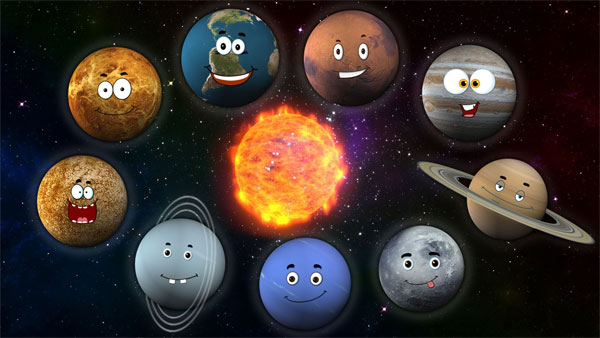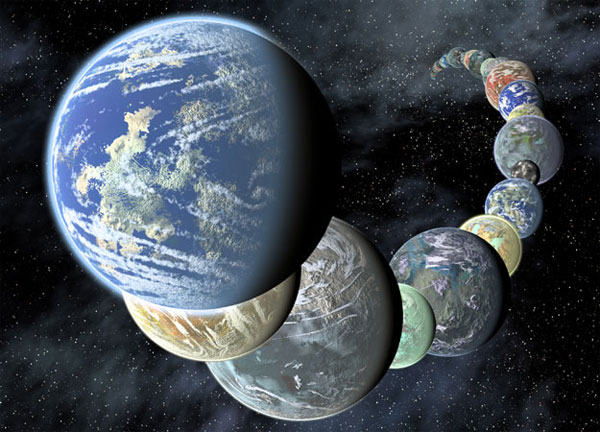Why are planets spherical, and meteorites?
In fact, the big planets all have spheres while meteorites have different shapes, however our Earth is not completely spherical.
It has been believed that Earth was a flat surface long ago, before science and astronomy provided the opposite evidence. Astronomers like Pythagoras believed that the Earth was not a plane thanks to observing the stars, even Eratosthenes accurately calculated the circumference of the Earth in the 2nd century BC. Until Columbus crossed the Atlantic Ocean and discovered America, it was completely believed that the Earth was spherical. In 1967, TIROS-1 satellite sent the first images of Earth taken from outer space and further confirmed that the Earth was spherical.

But why does Earth and all the planets and stars in the universe have a circle, not a square or any other shape?The answer is simple, because they are planets . Maybe many of you will be surprised, but please slowly let me explain. Scientists in an effort to distinguish large-sized planets and asteroids (or smaller-sized asteroids), they have found the key to determining the difference is the planets. Large sizes can hold spheres while smaller mass asteroids cannot .
Related to that mass is gravity , which can be said to be the main reason why stars and large planets are spherical . The huge mass of these planets creates an attractive force, theoretically focusing on its core. The newly formed planets may not have a certain shape, but gravity itself pulls matter from all directions to its center. So after millions and billions of years, these planets have a fixed shape that is spherical.

Many of you will think that the layers of rock on other planets as well as on Earth are very hard, so how can it deform to become a sphere like our kneading and molding. Well, the truth is that the layers of matter on planets have great hardness, but compared to the gravity of a planet, it is nothing. Especially in the center of the planet's temperature is often very high, enough to heat all matter and then gravity will ease the molding job easily, creating spherical planets.
However, you can easily see the surface of the Earth and the planets are not completely flat like a smooth drifting cake, there are high protrusions like hills and there are many deep depressions like the ocean floor. The cause of this is because during the gravitational force acting on the material layers, it pulls the rock layers into the center and creates geological tectonics that make the surface uneven. Besides, the outer layers of matter, on the surface, the gravity has been greatly reduced compared to the layers below. In addition, the surface temperature is significantly reduced, so the layers of rock remain solid and difficult to deform due to more gravitational force.

In fact, many parts of the Himalayas are higher due to the forces exerted from below, but other parts of the mountain range are collapsed due to the effects of gravity. The gravity of the Earth also prevents natural mountains from being too high by applying force in the opposite direction.
In addition there is a fact that not everyone knows, it is the Earth is not a perfect sphere . If the distance from the center to the sea level is calculated, the distance from the center of the Earth to the equator is 20km larger than the distance to 2 poles. Its cause is because the Earth rotates around it with the axis being a two-pole connecting line, so it causes a centrifugal force against gravity . This centrifugal force is the largest at the equator. For planets made up of lighter and faster spinning materials like Saturn and Jupiter, we can see quite clearly the bulging phenomenon in the equator.

Unlike planets and big stars, asteroids and meteorites are not spherical, but they have very different and unstable shapes. The reason is partly because their mass is very small , so gravity is also very weak and its impact is not enough to deform the material layers . In addition, planets form their shape during the early formation, when it is very hot and the matter seems to melt. While asteroids are fragments of collisions, its material layers are stable and shaped.
- Nearly 5,000 planets are threatening the earth
- The tiny spherical robots will explore Mars
- The surface of the 'giant' meteorite landed on Earth
- Why are stars and planets circular?
- Unknown mystery about planets outside the solar system
- Our solar system in the galaxy is rare
- Japan discovered 4 small meteorites in Antarctica
- Cosmic meteorite originated from ... Earth
- Discover more 18 large planets
- The small planet has an Earth-like crust
- Meteors can prove water exists on Mars
- The origin and name of meteorite
 Van Allen's belt and evidence that the Apollo 11 mission to the Moon was myth
Van Allen's belt and evidence that the Apollo 11 mission to the Moon was myth The levels of civilization in the universe (Kardashev scale)
The levels of civilization in the universe (Kardashev scale) Today Mars, the sun and the Earth are aligned
Today Mars, the sun and the Earth are aligned The Amazon owner announced a secret plan to build a space base for thousands of people
The Amazon owner announced a secret plan to build a space base for thousands of people